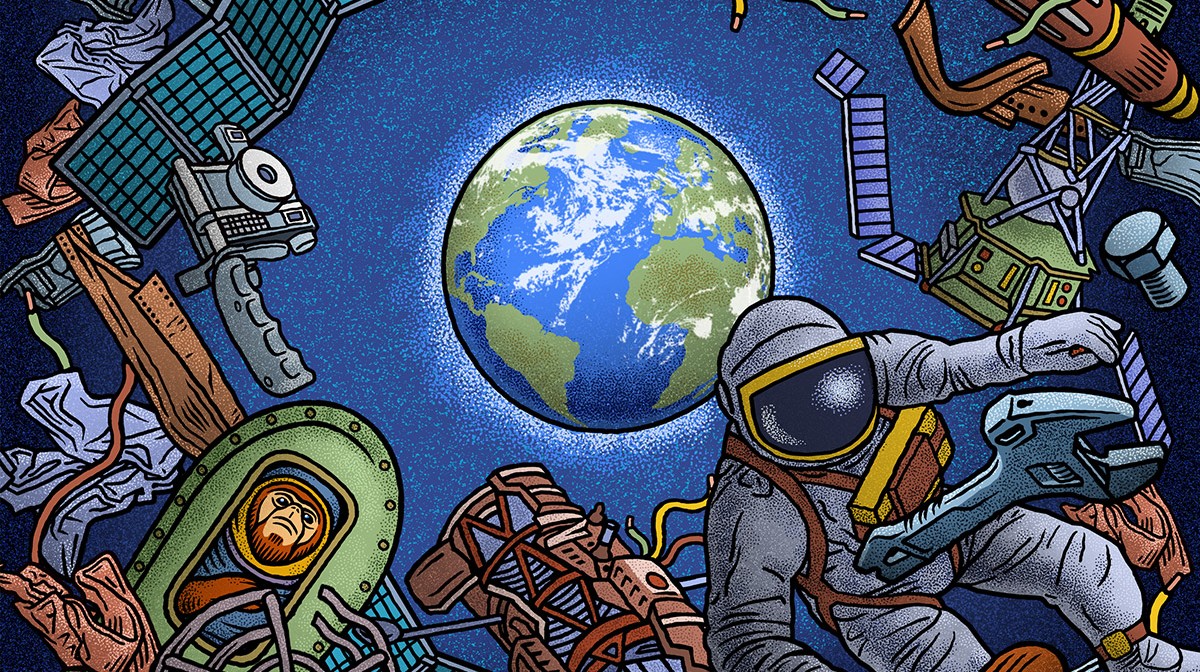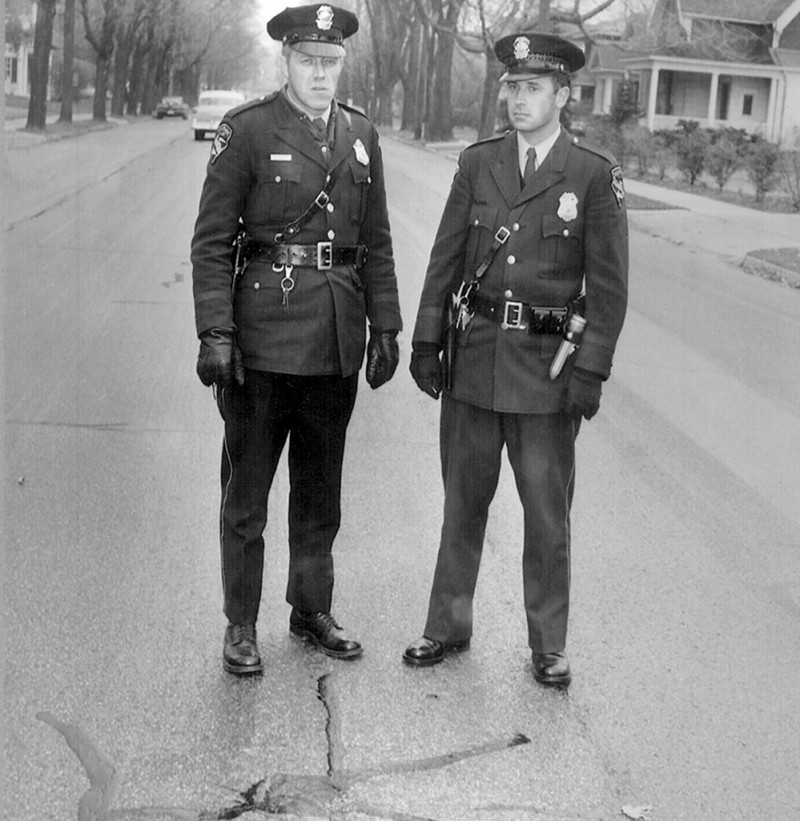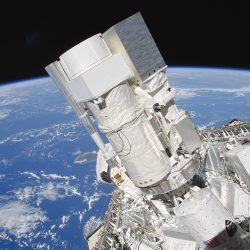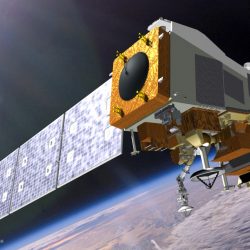
Lost in Space
50
years ago, the UW was a force behind the launch of the Orbiting Astronomical Observatory–2 (OAO–2), the first successful space telescope. Read more »
In September 1962, a 20-pound hunk of a Soviet spacecraft, still hot, landed in the middle of a Manitowoc street, rocketing Wisconsin into the space age. It wasn’t so much a sign of things to come on Earth, but it was a glimpse of what was to come in space: it was going to get crowded up there.
Just 60 years ago, the environment around our planet was pristine. But now there is an eclectic constellation of stuff. The list includes wrenches, toolboxes, and cameras left behind by astronauts, along with abandoned and broken satellites, spent rocket parts, and the cremated remains of celebrities and rich people (including Star Trek creator Gene Roddenberry). At least 23,000 other objects larger than a baseball, not to mention the millions of bits of debris too small to track, are speeding like shrapnel through space.
Also in orbit, of course, are plenty of working satellites. And their numbers continue to grow at an astonishing pace as the world’s spacefaring nations take advantage of new rocket technologies, miniaturization, and plummeting costs to seed space with more and more satellites.
“Satellites are in the background of just about everything we do in our daily lives. Modern-day America is tied to satellites. They are infrastructure,” explains space debris expert Lisa Ruth Rand, a science historian who was an A. W. Mellon postdoctoral fellow in UW–Madison’s Center for the Humanities from 2016 to 2018.
Within the next few years, the number of satellites in orbit may climb by as many as 20,000. This year alone, scores of small satellites have been lifted into Earth’s orbit, and the deployment of thousands more is already in the works. One ambitious proposal from the aerospace company SpaceX calls for placing as many as 12,000 small satellites in low-Earth orbit to create internet service networks.
Sometimes, the orbits of the things we launch into space — such as the bus-sized vacated Chinese space lab that came blazing back to Earth in April 2018 — degrade, and those objects streak through the atmosphere, often disintegrating and burning up. Cosmic debris also crashes into oceans and, occasionally, terra firma. But as the space around Earth gets more congested, the risk of debris crashing into spacecraft or working satellites (used for weather, navigation, communications, science, and defense) becomes significantly greater. In June, the Trump administration announced a space policy directive intended to prevent more collisions in the increasingly crowded orbits around the planet.
The first documented space wreck occurred in 2009, when a collision over Siberia between a defunct Russian military satellite and a commercial communications satellite created some 2,300 pieces of junk large enough to track by radar. The event inspired Rand, who once harbored aspirations to be an astronaut and grew up in Jacksonville, Florida, with a ringside seat for rocket and Space Shuttle launches from America’s “Space Coast.” She began to examine our legacy of space junk as an environmental issue, work she continued during her UW fellowship, cosponsored by the Department of History and the Nelson Institute for Environmental Studies. She is now hip deep in writing a book on the history of galactic garbage.
The saga is riveting: a tale of rocketing technological sophistication, Cold War clashes, cultural iconography, geopolitical maneuvering, and environmental hubris. Take, for example, Project West Ford. Initiated by the U.S. Air Force and MIT’s Lincoln Laboratory in the early 1960s, the aim was to fill space with millions of needlelike dipoles — magnetized wires — that could serve as emergency reflectors or antennae for radio signals in the event of a nuclear attack. The Air Force launched a test version and successfully used it to transmit cross-country signals, but the full-fledged project never followed. A few clumps of the project’s copper dipoles remain in their polar orbit 2,250 miles above Earth.
“Beginning with Sputnik, there’s been a pretty high awareness of the dangers of polluting space among scientific, government, and lay communities,” notes Rand, who holds research appointments at the Smithsonian National Air and Space Museum and the RAND Corporation. (RAND stands for Research and Development. No relation to the historian.)

In 1962, two Manitowoc police officers found a piece of Sputnik 4 that landed in the middle of a city street. Courtesy of the Rahr-West Art Museum
The first encounter with space junk for many was the world’s first baby step into space. Those who were alive when the first Sputnik was slung into orbit in 1957 remember dark nights in the backyard waiting for the “satellite” to pass overhead. What we were in fact seeing, says Rand, was the second stage of the rocket that carried Sputnik aloft. For the backyard observer, the satellite was too small to see.
Since then, the space around our planet has accumulated a cloud of orbiting debris. One early American satellite, Explorer 7, launched in 1959, carried the flat-plate radiometer, the world’s first space-based climate experiment. Devised by UW weather-satellite pioneer Verner Suomi and engineering professor Robert Parent ’39, MS’49, the radiometer was used to establish the critical role of clouds on climate and showed that Earth absorbed more of the sun’s energy than previously thought. The experiment aboard the 70-pound satellite paved the way for all future studies of weather and climate from space. Six decades later, it’s still in orbit.
Another UW contribution to the clutter around Earth is the Orbiting Astronomical Observatory–2 (OAO–2), the first successful space telescope. Launched in December 1968, OAO–2 carried Wisconsin-built telescopes that opened a new astronomical vista by providing access to light waves such as ultraviolet, which are blocked or absorbed by the atmosphere. This led to a raft of discoveries, including the identification of hydrogen halos around comets. Contact with OAO–2 was lost in January 1973, ending the mission and relegating it to the catalog of lifeless objects that circle our planet.
“[OAO–2 is] listed on various websites and apps that keep track of satellites, but I’ve never succeeded in seeing it fly over,” says Jim Lattis MA’87, PhD’89, a UW historian of astronomy and director of the university’s astronomy outreach outpost, Space Place. “It isn’t particularly bright.”
The observatory and its launch of space astronomy was an early milestone in the scientific community’s abiding interest in the environment immediately above our planet. For astronomers, programs such as Project West Ford were a threat, seeding space with objects that would reflect light and radio waves, wreaking havoc with astronomical observations.
Vigorous lobbying to impose some international regulation of Earth’s orbit was the prelude to the first space treaties. The effort spurred one annoyed diplomat to scrawl a hand-written note on a State Department resolution, discovered by Rand during her research, describing astronomers as “a noisy and parochial group.”
But sooner or later, depending on altitude, everything comes back to Earth. Many objects spend only a short time in space, a few years to mere days. Objects in very high geostationary (matching Earth’s rotation) orbits — 22,000 miles and above — would be there for thousands of years, except that international convention requires that maneuverable satellites in those high orbits be brought down when their missions are complete. Although various schemes have been proposed to clean up space — nets, harpoons, robotic arms, space tugs — “we often allow outer space to clean up our mess for us. Earth orbit, like the ocean and the atmosphere, is a waste sink,” Rand says.
Certain orbits, especially geostationary and polar orbits for large maneuverable satellites, are a precious and finite resource. There are “good orbits” to be in, notes UW meteorological satellite guru Steve Ackerman. For example, key weather satellites are lined up in less-cluttered orbits, keeping them safely away from other working satellites to ensure they can avoid collisions and do their jobs.
4,600
satellites in Earth’s orbit (2,000 are operational)
500,000
pieces of debris tracked as they orbit Earth
17,500 mph
The speed at which debris travels
$4,995
The price Celestis Memorial Spaceflights charges to launch remains into Earth’s orbit. Previous customers include:
- Gene Roddenberry, Star Trek creator
- Gerard K. O’Neill, space physicist
- Timothy Leary, psychologist and writer
- James “Scotty” Doohan, actor
- L. Gordon “Gordo” Cooper Jr., astronaut
Right outside Manitowoc’s Rahr-West Art Museum, in the middle of one of the Wisconsin city’s busiest thoroughfares, is a brass ring set flush in the pavement. Placed by the International Association of Machinists in 1963, the plate-sized ring marks the spot where, in the early morning hours of September 5, 1962, two city patrol officers making their rounds discovered a piece of steel embedded three inches deep in the pavement of North Eighth Street. It was from an unmanned Soviet spacecraft — dubbed Sputnik 4 in the West — rumored to be carrying a prototype spacesuit as a test for crewed flights. Its flight went awry due to a bug in the guidance system, and instead of a planned, controlled glide to Earth, the ship was boosted to a higher orbit. The seven-ton spacecraft eventually re-entered the atmosphere, where most of it vaporized — except for a few bits that landed in Wisconsin.
Although Rahr-West is dedicated to fine art, the museum has a small display of artifacts — a cast replica of the spacecraft fragment, pictures, and newspaper clippings — to memorialize Manitowoc’s unique place in the history of the space race.
“Being able to recover part of a spaceship was a rare thing,” Rand says. “It is one of the few pieces of space debris — outside of the space shuttle Columbia accident — that has been recovered on American soil.”
The remains of Sputnik 4 became a Cold War prop as the United States sought to return the debris to the Soviets on the floor of the United Nations, demonstrating for all the world that early Russian spaceflight technology didn’t necessarily match the nation’s boasts.
The only other confirmed example of space junk found on American soil is also the only documented case of space debris striking a human. In January 1997, Lottie Williams was hit by a bit of fabric debris from an American Delta II booster rocket while walking in a Tulsa, Oklahoma, park. “Lottie was lucky,” according to one 2014 account: she was hit by the smallest piece of wreckage from the disintegrated rocket. A 66-pound titanium pressure tank was recovered in Texas.
For Rand, a visit to Rahr-West — where museum curator Adam Lovell places a thin file of letters, reports, and yellowed newspapers on a conference room table for her perusal — is another opportunity to research her story of space debris. The museum, for its part, takes full advantage of its proximity to Sputnik 4’s ground zero. Each year in early September, the museum hosts Sputnikfest, a quirky celebration featuring a Ms. Space Debris pageant (a contest open to any “human life-form,” in which Rand has twice placed as runner-up).
The crash of Sputnik 4 into one of Manitowoc’s busiest streets decades ago is a convenient touchstone for Rand, who came to the UW in 2016 after completing her doctorate in history and sociology of science at the University of Pennsylvania. The debris that falls from space, she has learned, is almost never recovered, instead burning up or falling in the oceans that cover most of our planet. Exceptions include the U.S. space station Skylab, which re-entered the atmosphere in 1979, pocking the Australian Outback with at least 22 tons of wreckage in 500 pieces — some the size of a loveseat.
And then there’s the example of Kosmos 954, a nuclear-powered Soviet reconnaissance satellite launched in 1977. A malfunction prevented the satellite from safely shedding its uranium-powered reactor core, and when it re-entered the atmosphere in 1978, it scattered radioactive debris over 48,000 square miles of Northwest Canada.
The incident prompted an exhaustive international air and land sweep to find and scoop up large pieces of radioactive debris — one reportedly so hot that a few hours of exposure would have been fatal.
International incidents created by stuff that falls randomly from the sky date almost to the beginning of the Space Age. In 1960, Rand notes, a failed rocket launch from Cape Canaveral resulted in debris raining down on newly Communist Cuba. A piece of debris supposedly struck and killed a cow, inspiring the first student-led anti-American demonstration there. The United States reportedly paid $2 million in compensation for the beaned bovine. It was a gift, too, for headline writers: the “Herd Shot Around the World.”
Terry Devitt is UW–Madison’s director of research communications.
Published in the Spring 2019 issue



Comments
No comments posted yet.